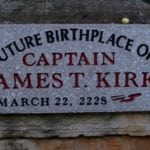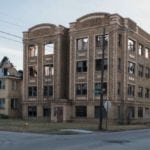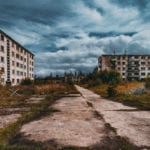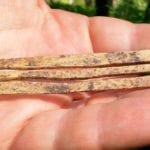 Animals
Animals  Animals
Animals  Weird Stuff
Weird Stuff 10 Weird Things People Used to Do at New Year’s
 Our World
Our World 10 Archaeological Discoveries of 2025 That Refined History
 Weird Stuff
Weird Stuff 10 Fascinating Facts You Might Not Know About Snow
 Miscellaneous
Miscellaneous Top 10 Things Crypto Was Supposed to Change & What Actually Did
 History
History 10 Huge Historical Events That Happened on Christmas Eve
 Music
Music 10 Surprising Origin Stories of Your Favorite Holiday Songs
 History
History 10 Less Than Jolly Events That Occurred on December 25
 Weird Stuff
Weird Stuff 10 Funny Ways That Researchers Overthink Christmas
 Politics
Politics 10 Political Scandals That Sent Crowds Into the Streets
 Animals
Animals 10 Species That Refused to Go Extinct
 Weird Stuff
Weird Stuff 10 Weird Things People Used to Do at New Year’s
 Our World
Our World 10 Archaeological Discoveries of 2025 That Refined History
Who's Behind Listverse?

Jamie Frater
Head Editor
Jamie founded Listverse due to an insatiable desire to share fascinating, obscure, and bizarre facts. He has been a guest speaker on numerous national radio and television stations and is a five time published author.
More About Us Weird Stuff
Weird Stuff 10 Fascinating Facts You Might Not Know About Snow
 Miscellaneous
Miscellaneous Top 10 Things Crypto Was Supposed to Change & What Actually Did
 History
History 10 Huge Historical Events That Happened on Christmas Eve
 Music
Music 10 Surprising Origin Stories of Your Favorite Holiday Songs
 History
History 10 Less Than Jolly Events That Occurred on December 25
 Weird Stuff
Weird Stuff 10 Funny Ways That Researchers Overthink Christmas
 Politics
Politics 10 Political Scandals That Sent Crowds Into the Streets
10 Small Towns Devastated By Sudden Killing Sprees
A murder spree can hit any city, but when one occurs in a small town, the disaster is felt by everyone in town personally. In a small town, especially one where everyone in the community knows everyone else, it can be utterly devastating. In a spree, the survivors could lose several friends, family, and neighbors in the matter of hours or days. They may have even known the killer for years before they finally snapped.
10McCarthy, Alaska

When it comes to small towns, McCarthy, Alaska, is about as small as it gets. In 1983, 22 people lived in the former mining town about 400 kilometers (250 mi) away from Anchorage. One of the people living there was 39-year-old Louis Hastings, an out-of-work computer programmer. Hastings had moved to the town about eight months earlier from California to work on a cabin that he owned.
On February 28, 1983, Hastings spent the night playing the board game Risk with his friend Chris Richards. Hastings won. The next day, Hastings paid Richards a visit. Richards invited Hastings in for a coffee, and when he went to get a mug, Hastings shot him above the right eye and in the neck. Hastings then said, “Look, you’re already dead. If you’ll just quit fighting, I’ll make it easy for you.” Instead, Richards slashed him with a knife and was able to escape in his stocking feet. A neighbor on a snowmobile spotted Richards and picked him up, and they fled from Hastings.
After shooting his friend, Hastings went to the airstrip, where the weekly mail delivery attracted many of the town’s citizens. They often hung out there and chatted while waiting for the plane to land. When Hastings arrived at the airstrip, he shot six people to death and injured another woman, who managed to escape and hide. Hastings then drove away from the town on a snowmobile.
Richards and the other neighbor drove to the airstrip, where a private pilot flew them to Glennallen, which is about 160 kilometers (100 mi) away. The police then flew to McCarthy and found Hastings about 30 kilometers (20 mi) away from the town. He was arrested without incident.
Hastings said he planned on killing everyone in the town, then he was going to hijack the mail plane and have the pilot fly him to Glennallen. Once there, he was going to steal a truck and then blow himself up—along with the Trans-Alaska oil pipeline pump station. Instead, Hastings received 634 years in prison for the six murders. Richards and the other woman survived their injuries.
9Gaffney, South Carolina

Gaffney, South Carolina, is a small town with just over 12,500 people, and it was a quiet town until 41-year-old Patrick Tracy Burris descended upon it. Burris had a lengthy criminal record: He had been arrested over 30 times. He had just been let out of prison on April 29, 2009, after spending almost eight years in a prison in North Carolina for felony breaking and entering.
For reasons that remain unclear, Burris left North Carolina, violating his parole, and he traveled to Gaffney. Burris’s rampage started on June 27, 2009, when 63-year-old Kline Cash was found shot to death in his home. Four days later, 83-year-old Hazel Linder and her daughter, Gena Linder Parker, were found bound and shot to death in Linder’s home. The next day, Stephen Taylor, 48, and his 15-year-old daughter Abby were murdered in their family furniture store.
The killing spree came to an end on July 6, in Dallas, North Carolina, a short distance from Gaffney. Officers were called to a robbery in progress. The police confronted Burris, he pulled a gun, and the police shot him. After his death, his gun was linked to the five murders.
8Alger, Washington
Alger, Washington, is a town of about 400 people, and one of the most well-known residents was 28-year-old Isaac Zamora. Zamora wasn’t well known for good reasons; his odd behavior made him stick out among the people in the town. He wasn’t known to be violent, but he did spend time in jail. He had just been released from prison on August 6, 2008, after serving six months. After release, his behavior had become more erratic.
On September 1, 2008, Zamora broke into a house in Alger and started arguing with the resident. The police were called and made Zamora leave the house. The next day, Zamora’s mother called the police because Zamora was again trespassing, but this time, he broke into a neighbor’s house and stole a Winchester rifle, a handgun, and some ammunition. Once he was armed, he went and murdered his mother’s neighbor, 58-year-old Chester Rose. By that time, deputy Anne Jackson had arrived on the scene, and the ensuing gunfight left the 40-year-old deputy dead.
Zamora then went to two more houses. In the first house, he killed Julie Binschus, 48, and in the second, he murdered Greg Gillum and David Radcliffe, who were doing construction on the house. After murdering the men, he stole their truck. Before he left Alger, Zamora shot a man and stabbed another; both survived.
Zamora then hit the freeway. There, he fired at several cars, killing the driver of one of the vehicles and injuring another two in a different car. Around 5:00 PM, about three hours after the rampage started, Zamora pulled into the parking lot of the sheriff’s department and surrendered. He had claimed the lives of six people and injured four others.
In a plea deal, Zamora was found not guilty by reason of insanity, but a clause said that if he ever recovered, he would have to do four life sentences in prison. In 2012, Zamora was transferred to a prison because they thought he was a possible danger to staff, patients, and even the public.
7Tyrone, Missouri
On February 26, 2015, 36-year-old Joseph Jesse Aldridge came home to find his mother dead from natural causes; she had been suffering from lung cancer. Investigators believed that this might have caused Aldridge to snap.
In the early morning of February 27, he drove his truck around Tyrone, Missouri, which has a population of fewer than 50 people. He went to four different houses in the town and shot a total of seven people and injured another woman with a handgun. Out of the victims, two were his cousins and their wives, and the other three victims were neighbors. All the victims lived within a few miles of each other. After murdering seven people in their homes, Aldridge drove a short distance away and turned the gun on himself.
The killing spree shocked the little community. With so few people living there, almost everyone knew the victims and the killer.
6Manley Hot Springs, Alaska

After several run-ins with the law in Illinois, 25-year-old drifter Michael Silka traveled to Alaska. In April 1984, Silka was staying in a cabin in Fairbanks. On April 28, people saw Roger Culp go into Silka’s cabin. Later that day, neighbors heard gunshots, and in the ensuing days, they noticed that Culp had gone missing. Silka was a person of interest in the disappearance, but he didn’t stay around long. He was next spotted in Manley Hot Springs on May 14, 1984. Manley Hot Springs was a town of about 80 people.
Silka was seen around the boat landing, and since there were so few people in the town, several met and spoke with Silka in the week that he was there. On the afternoon of May 17, six people went to the boat landing between 4:00 and 6:00 PM and disappeared. This included an injured Vietnam veteran and a family that consisted of a young father, his four-months pregnant wife, and their young son. Other townspeople did not notice they were missing until the next afternoon. They also noted that Silka was no longer around.
The Alaska State Troopers were called. Using helicopters, they tracked Silka to a boat stolen from another missing man who lived in the area. The police gave chase and ordered Silka to surrender. He refused. Instead, he fired his rifle at one of the helicopters, killing trooper Troy Duncan. The police returned fire; Silka was hit five times and died as a result of his injuries.
Altogether, Silka murdered seven people in the town—six at the boat landing, plus the owner of the boat he stole. After shooting his victims, he dumped their bodies in the muddy Tanana River. It is believed that Silka got into an argument at the boat landing and killed the person he was arguing with. He then killed anyone else who came to the boat landing because they might have been potential witnesses. Only four of the bodies were ever recovered.
5San Jeronimo de Juarez, Mexico

On July 31, 2006, the coastal town of San Jeronimo de Juarez, Mexico, with a population of about 7,300 people, was the setting of a violent murder spree. It started when 24-year-old Oscar Flores killed his infant nephew with a knife and then started beating another boy in the house. The police arrived, and Flores turned his attention to them. He beat one of the two officers with a rock and was able to wrestle away the officer’s assault rifle. The other officer fled, and Flores walked through the town and started shooting random people with the assault rifle. He managed to kill 11 people, including a three-year-old boy, before the townspeople turned on him. He was chased into the town square, and during the chase, he lost his gun and his clothes. He faced off against the townspeople naked and armed with a machete. The police ended up shooting him, and he died in the hospital a short time later.
Flores had just returned to San Jeronimo two months before he went on his rampage. Several years prior, he had murdered his brother-in-law and fled to San Diego. While living there, he became addicted to cocaine. It is believed that he was high during his rampage. Flores was also the suspect in five other murders in Tijuana.
4Velika Ivanca, Serbia
Velika Ivanca is a Serbian town of about 1,500 people and is about 50 kilometers (30 mi) away from the capital city of Belgrade. At 5:00 AM on April 9, 2013, 60-year-old veteran of the Croatian War of Independence Ljubiaa Bogdanovi took a gun and killed his mother and his 42-year-old son. He also shot his wife, Javorka, in the head.
After shooting each family member in his house, Bogdanovi went from house to house over the span of half an hour and killed each of his neighbors as they slept. In total, he entered four houses and murdered five men, five women, and a two-year-old boy.
Around 5:30 AM, police responded to the shooting. When they arrived, Bogdanovi shot himself, and he died in the hospital. Jovorka was the sole survivor of the massacre that claimed 13 lives. No clear motive for the shootings was ever determined.
3The Villages Of Cumbria, England
In the early morning hours of June 2, 2010, 56-year-old taxi driver Derrick Bird drove to his twin brother’s house in the small village of Lamplugh (population: 763). The two had previously argued over an issue with a will. Bird shot his twin brother 11 times in the head with a rifle. He then drove to the family solicitor’s house in Frizington. Bird thought that the solicitor and his brother were conspiring to send him to prison over a tax issue. The solicitor was shot twice with a shotgun and died.
Bird then drove into Whitehaven, which had a population of around 25,000. There, he targeted four fellow cab drivers. One died, and three others were injured. That’s when police gave chase, but Bird was able to elude them by shooting a motorist who was driving toward him. One of the pursuing officers had to stop to help the motorist. Bird lost the second police vehicle when he turned around in a driveway and pointed a gun at the officers. They were unarmed, so they were forced to let him go.
After eluding capture, he drove through the towns of Egremont (7,500), Gosforth (1,230), and Seascale (1,700). As he drove, he would shoot at random people, generally middle-aged of either sex. They would either pass him on the road in a car, were out cycling, or were just walking. He managed to kill nine more people and injure another seven.
By 12:30 PM, Bird was out of gas, out of shotgun shells, and one of his front tires was gone. He walked into a wooded area near Boot, and at around 1:30 PM, he was found dead by his own hand. His 10-hour murder spree claimed the lives of 12 people, and 11 others were injured.
2Luxiol, France
The approximately 130 residents of Luxiol were aware that Christian Dornier might be a problem. He had never had any run-ins with the law, but he was considered an odd, angry 31-year-old who lived on one of the farms in the village. The village council suggested to his family that he should get psychological help.
On July 12, 1989, at about 2:30 PM, for no apparent reason, Dornier took a 12-gauge double-barrel shotgun and shot his 26-year-old sister. She’d gotten married just four days earlier. She died instantly. Dornier then shot his mother and his father. His father would survive the attack, but his mother wouldn’t.
Dornier left his younger brother and brother-in-law unharmed and got in his car. Over the next two hours, he drove around the village shooting at anyone he came across. This included two girls who were five and 10 years old. Dozens of officers pursued Dornier as he headed to the village of Verne. Once there, he fired at the police, and they shot back, hitting him in the stomach, but he survived.
Including his family members, Dornier killed 14 people and injured 10 more people. After the rampage, Dornier was found not guilty by reason of insanity.
1Hungerford, England

Hungerford is a small market town about 100 kilometers (60 mi) from London, and it has a population of about 5,000 people. On August 10, 1984, 27-year-old gun enthusiast Michael Robert Ryan drove to a forest about 15 kilometers (10 mi) outside of the town. There, he watched 33-year-old Susan Godfrey and her son and daughter have a picnic. Just after noon, they were packing up, and Ryan, dressed all in black, approached them with a pistol aimed at Godfrey. He got her to put her children in the car and then took her to a secluded area, where he shot her 13 times. He then drove back to the town, stopping off at a gas station first, where he filled up his car and a can of gas. He fired at the employee working there, but the gun misfired twice, and he left her alive.
At about 12:45 PM, Ryan arrived at his mother’s home. Neighbors watched him walk into the house and then heard a shot fire; he had killed the family dog. He loaded some guns into his car, including an AK-47 and an M1 carbine semi-automatic assault rifle. When he went to drive away, his car wouldn’t start. Instead, he got the can of gas out of the car, soaked the house, and then set it on fire.
He walked away from the house and encountered two neighbors. He killed both and then fired at another one. He then wandered around his neighborhood, randomly shooting at anyone he saw. He warned children to get off the road. Yet, he had no problem shooting a 14-year-old girl four times (she survived).
When his mother arrived home, she got out of her car, and upon seeing her son, she said, “Stop, Michael. Why are you doing this?” He shot her four times, killing her. He then walked toward the popular weekly market and fired indiscriminately at anyone who came across his path. After about two hours, he was seen entering his former high school, which didn’t have any classes because it was summer. The police surrounded the building. At 6:52 PM, he fatally shot himself.
In total, over the span of two hours, he managed to kill 16 people and injure 15 more. It was one of the worst mass murders in modern England and led to stricter gun laws.
Robert Grimminck is a Canadian freelance writer. You can friend him on Facebook, follow him on Twitter, or visit his website.





